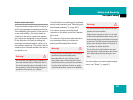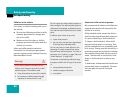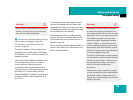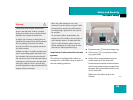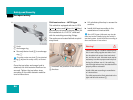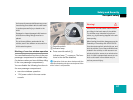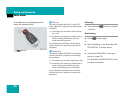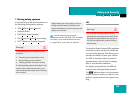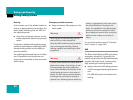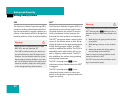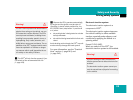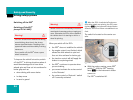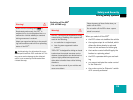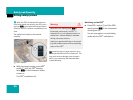
89
Safety and Security
Driving safety systems
̄ Driving safety systems
In this section you will find information on
the following driving safety systems:
ț ABS (Antilock Brake System)
ț Adaptive Brake
ț BAS (Brake Assist System)
ț EBP (Electronic Brake Proportioning)
ț ESP
®
(Electronic Stability Program)
ABS
The Antilock Brake System (ABS) regulates
the brake pressure so that the wheels do
not lock during braking. This allows you to
maintain the ability to steer your vehicle.
The ABS is functional above a speed of
approximately 5 mph (8 km/h) indepen-
dent of road surface conditions.
On slippery road surfaces, the ABS will
respond even with light brake pressure.
The - indicator lamp in the instrument
cluster comes on when you switch on the
ignition. It goes out when the engine is run-
ning.
Warning! G
The following factors increase the risk of
accidents:
ț Excessive speed, especially in turns
ț Wet and slippery road surfaces
ț Following another vehicle too closely
The driving safety systems described in this
section cannot reduce these risks or pre-
vent the natural laws of physics from acting
on the vehicle.
Always adapt your driving style to the pre-
vailing road and weather conditions and
keep a safe distance to other road users and
objects on the street.
i
In winter operation, the maximum
effectiveness of the ABS, BAS, ESP
®
and Adap-
tive Brake is only achieved with winter tires
(
୴ page 328) or snow chains as required.
Warning! G
Do not pump the brake pedal. Use firm,
steady brake pedal pressure instead. Pump-
ing the brake pedal defeats the purpose of
the ABS and significantly reduces braking
effectiveness.



